Lecture
Electronic equipment used in communication devices and systems is currently mainly powered by AC 220 V. Therefore, it is very important to understand the characteristics of the voltage in this network. In accordance with the requirements for sources of electricity ~ 220 V in accordance with GOST R 54149 - 2010:
In addition, the network allows the appearance of a pulse increase or decrease in voltage up to 10 ms and fast voltage changes with a frequency of up to 8 Hz and a voltage of up to 1.38 from the nominal value. The voltage form can also be non-harmonic and asymmetric [2]. All these phenomena can lead to instability in the operation of electronic equipment powered by 220 V.
The widespread classical scheme of power supply of electronic equipment ensures uninterrupted power supply. The same functions are performed by other devices that are successfully developed, are separated into a separate class and received the name of an uninterruptible power supply (UPS) device, sometimes they are called uninterruptible power supplies (UPS).
Uninterruptible power supplies make it possible to improve the quality of electric power for electronic equipment and its individual components. A generalized classification of uninterruptible power supplies is shown in Figure 1.
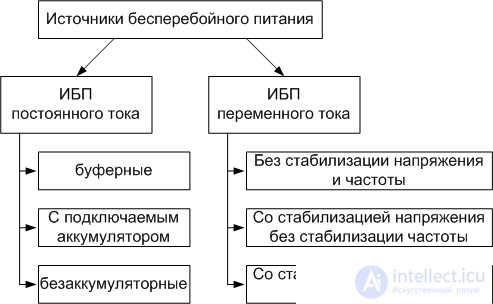
Figure 1. Classification of uninterruptible power supplies
The simplest uninterruptible power supply circuit is a buffer circuit. It uses a battery or a battery of chemical elements as the primary source of power for direct current. A schematic diagram of the buffer connection of the battery to the load is shown in Figure 2.

Figure 2. Buffer circuit of uninterruptible power supply DC
As the main advantage of the buffer circuit connecting the battery should be noted its simplicity. In most schemes of modern portable electronic equipment this scheme is used. In the buffer connection scheme, the battery is involved in the suppression of interference from the power source. This is another advantage of the DC uninterruptible power supply buffer circuit.
As a disadvantage of the buffer circuit, it should be noted the difficulty of the charge-discharge mode of the battery. As a result, batteries often fail. To the design of the battery, too, there are increased requirements - during its work should not be allocated gases that can destroy electronic equipment. For example, during the operation of acid batteries, vapors of acid may be emitted, therefore this type of battery, capable of providing significant currents with small dimensions of the battery, is not used in uninterruptible power supplies. When working with alkaline batteries, it is very important to ensure that the battery is completely discharged, otherwise the battery will quickly fail. Nowadays, either metal hydride or lithium-ion batteries are commonly used, which are less susceptible to the problem described. Nevertheless, from time to time it is required to perform a battery run - several full charge-discharge cycles of batteries.
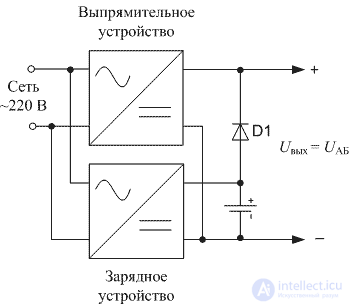
Figure 3. Diagram of uninterruptible power supply DC with separated AB
Uninterruptible Power Supply (UPS) Uninterruptible Power Supply (UPS ) is a source of secondary power supply, an automatic device whose purpose is to provide electrical equipment connected to it with uninterrupted power supply within normal limits.
GOST 13109-97 (instead of GOST 13109-87) defines the following standards in the power supply network: voltage 220 V ± 5% (limit values ± 10%); frequency 50 Hz ± 0.2 Hz (limit values ± 0.4 Hz); coefficient of non-linear distortion of the voltage form is less than 8% (long-term) and less than 12% (short-term).
The network faults are:
The mass use of the UPS is related to ensuring the uninterrupted operation of computers, allowing equipment connected to the UPS when there is a loss of electric current or when its parameters go beyond acceptable limits, some short time (usually up to 10-15 minutes) to continue working. In addition to computers, the UPS provides power and other electrical loads that are critical to the availability of power with normal parameters of the power supply network, such as control circuits for heating boilers. The UPS is able to adjust the parameters (voltage, frequency) of the output network. Extremely rare instances can be combined with various types of electric power generators (for example, a diesel generator).
Important indicators that determine the choice of the UPS design scheme are load transfer time to battery power and battery run time.
Laptops and other devices that have a built-in rechargeable battery, do not need a UPS - a battery with built-in switching schemes is itself.
There are three schemes for building a UPS:
Backup circuit (English Off-Line, Standby ) - in normal mode, the connected load is supplied directly from the primary electrical network, which the UPS filters (high-voltage pulses and electromagnetic interference) with passive filters. When the power supply exceeds the normalized voltage values (or its loss), the load is automatically reconnected to the power supply from a circuit that receives electrical energy from its own batteries using a simple inverter. When a voltage within normal limits, again switches the load on the power from the primary network.
Virtues
disadvantages
Bottom line: Most often, UPSs built according to this scheme are used to power personal computers or workstations of entry-level LANs, for which a timely shutdown in the event of a network failure is not critical. Almost all low-cost low-power UPSs offered on the domestic market are built according to this scheme.
Interactive scheme (eng. Line-Interactive ) - the device is similar to the previous scheme; Additionally, a step voltage regulator is present at the input on the basis of an autotransformer, allowing you to get an adjustable output voltage. (VI according to IEC classification). When operating in normal mode, these UPSs do not adjust the frequency, passive filters filter the incoming AC voltage. When the power fails, the UPS transfers to power from the inverter, similar to the previous one.
Inverters of some models of linear-interactive UPS provide voltage as a rectangular or trapezoidal shape, as in the previous version, and sinusoidal form. The switching time is shorter than in the previous version since the inverter is synchronized with the input voltage. KPDnezhny, than at reserve.
Disadvantages: in the “from the network” mode, it does not perform the function of peak filtering, and provides only extremely primitive voltage stabilization (usually 2-3 steps of the autotransformer, switched relay, the function is called “AVR”).
In the “on battery” mode, some, especially cheap, circuits supply a frequency much higher than 50 Hz to the load, and an oscillogram of alternating current that has little in common with a sinusoid. This is due to the use of a classic large-size transformer in the circuit (instead of an inverter on semiconductor switches). Due to the fact that a transformer of this size has (due to hysteresis in the core) a limit on the transmitted power, which rises linearly with the frequency of this transformer (it takes 1/3 of the volume of the whole UPS) is enough to power the battery charging circuit at 50 Hz in the mode "from the network." But, in the “on battery” mode, hundreds of watts of power have to be passed through this transformer, which is possible only by increasing the frequency.
This leads to the inability to power devices using, for example, asynchronous motors (almost all the so-called “white appliances”, including heating systems).
In fact, from such a UPS it is possible to supply only devices that are not demanding to the quality of power, that is, for example, all devices with pulsed power supplies, where the supply voltage is immediately rectified and filtered. That is, computers and much of modern consumer electronics. You can also power the lighting and heating devices.
Double conversion mode [1] ( online , online) - is used to power loaded servers (for example, file servers), high-performance workstations of local computer networks, as well as any other equipment that places high demands on the quality of the power supply (CHECK: server load has no relation to the choice of the UPS circuit, in addition, all the impulse power supplies, and especially high quality ones used in servers of serious manufacturers, have, on the contrary, REDUCED quality requirements wu supply voltage). The principle of operation consists in double conversion of the current type. First, the input AC voltage is converted to DC, then back to AC voltage using an inverter (inverter). When the input voltage disappears, switching the load to the battery power is not required, since the batteries are permanently connected to the circuit (the so-called battery backup mode) and the “switching time” parameter doesn't make sense for these UPSs. For marketing purposes, the phrase “switching time is 0” can be used, correctly reflecting the main advantage of this type of UPS: no time gap between the loss of external voltage and the start of battery power. Double conversion UPSs have low efficiency (from 80 to 96.5%) in on-line mode, due to which they are characterized by increased heat generation and noise level. However, modern medium-size and high-capacity UPSs from leading manufacturers have a variety of intelligent modes that allow you to automatically adjust the mode of operation to increase efficiency up to 99%. In contrast to the two previous schemes, they are able to correct not only voltage, but also frequency (VFI according to IEC classification).
Virtues
disadvantages
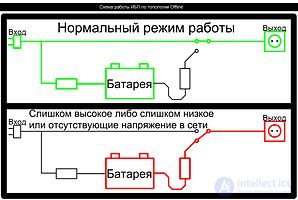
“Backup” UPS construction scheme
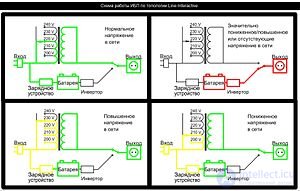
"Interactive" UPS construction scheme
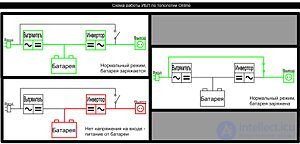
Double Conversion UPS System
Some types of loads use protective earth conductor (PE) for their working needs.
For example, such is the equipment with gas burners, where the flame control ionization electrode circuit is closed through the burner ground and then through the PE wire. Existing regulations on electrical installations allow such tiny (microamps) operating currents through PE.
This is not a problem with the mains supply, both the TN-CS network and the TT network, since in both of them PE sooner or later communicates with N through the dividing point in the TN-CS or through the physical earth from the consumer to the transformer station with a grounded neutral in the case of a TT, in addition, in the TT network it is also possible to re-ground N on the way from the TP to the consumer. In this case, the above described circuits in the device, connected between L and PE, are operational.
However, in the case when the device is powered from an absolutely isolated and not grounded source (in this case, from a UPS operating on batteries), where there are often no concepts of “phase” and “zero”, but there are 2 sine 110 V out of phase (this the so-called “IT system”), the above-described circuits have a problem due to the lack of any PE message and power supply on the source side (PE can still be used on the source for protective grounding of the housing, screens, etc.).
In practice, this means the absence of the “there is a flame” signal on the automation of the heating boiler and its inoperability.
It is for the support of such consumers that the UPS uses a “through zero” scheme, that is, a direct connection of the N terminals of the input and output power circuits. In this case, even when running on batteries, there is a PE and N message on the load (through the UPS and then through the network where the UPS is connected), and the above described problem does not occur.
However, this situation occurs only in the event of a loss of input voltage to the UPS, for example, due to the actuation of the “automaton” or disconnection from the energy supplier.
In some other situations - tripping of the RCD, complete disconnection of the UPS input from the mains with a plug, “zero firing” on the village overhead line - even the “pass-through zero” in the UPS is not enough to power the above circuits. In this case, it is recommended (for example, by Buderus for heating boilers, the recommendation generally applies to IT supply networks) to install a resistor of about 1..10 MΩ (Buderus recommends purchasing their original resistor, its resistance 10 MΩ) between N and PE at the input of the powered device (or at the output of the UPS).
|
|
This article or section may contain non-encyclopedic material.
Please improve it according to the rules for writing articles. |
|
|
This article or section needs to be recycled.
Please improve the article according to the rules of writing articles. |
Реализация основной функции достигается работой устройства от аккумуляторов, установленных в корпусе ИБП, под управлением электрической схемы, поэтому в состав любого ИБП, кроме схемы управления , входит зарядное устройство , которое обеспечивает зарядку аккумуляторных батарей при наличии напряжения в сети, обеспечивая тем самым постоянную готовность к работе ИБП в автономном режиме. Для увеличения автономного режима работы, можно оснастить ИБП дополнительной (внешней) батареей.
Режим байпас (англ. Bypass , «обход») — питание нагрузки отфильтрованным напряжением электросети в обход основной схемы ИБП. Переключение в режим Bypass выполняется автоматически или вручную (ручное включения предусматривается на случай проведения профилактического обслуживания ИБП или замены его узлов без отключения нагрузки). Байпасом называется один из составляющих ИБП блоков. Может делать т. н. фазануль(«сквозной нуль»). Применяется в online схемах, более того, выключенный кнопкой OFF online UPS остаётся в режиме байпаса, то же самое происходит при разрушении силовых компонентов схемы, определённом управляющими цепями, а также при аварийном отключении схемы по перегрузке выхода. В line-interactive UPS режим работы «от сети» и есть байпас.
" Booster " (English booster ) - the step automatic voltage regulator (English Automatic Voltage Regulation, AVR ), имеющий автотрансформатор в своей основе. Используется в ИБП, которые работают по интерактивной схеме. Часто ИБП оснащается только повышающим «бустером», который имеет всего лишь одну либо несколько ступенек повышения, но есть модели, которые оснащены универсальным регулятором, работающим и на повышение (boost), и на понижение (buck) напряжения. Использование бустеров позволяет создать схему ИБП, способную выдержать долгие глубокие «подсадки» и «проседания» входного сетевого напряжения (одной из наиболее распространённых проблем отечественных электросетей) без перехода на аккумуляторные батареи, что позволяет значительно увеличить срок «жизни» аккумуляторной батареи.
Схема инвертора 12 Вольт постоянного в 230 Вольт переменного напряжения
Инвертор — устройство, которое преобразует род напряжения из постоянного в переменное (аналогично переменное в постоянное). Основные типы инверторов:
Показатель, который характеризует степень отличия формы напряжения или тока от идеальной синусоидальной формы — коэффициент нелинейных искажений (англ. Total Harmonic Distortion, THD ). Типовые значения:
Для уменьшения влияния на форму напряжения в питающей электросети, (если входным узлом ИБП, построенного по схеме с двойным преобразованием, являетсятиристорный выпрямитель, элемент нелинейный и потреб***яющий большой импульсный ток, такой ИБП становится причиной появления гармоник высшего порядка) во входной цепи ИБП устанавливается специальный THD-фильтр . При использовании транзисторных выпрямителей коэффициент нелинейных искажений (англ. Total Harmonic Distortion, THD ) составляет порядка 3 % и фильтры не используют.
Гальваническую развязку между входом и выходом (как правило, в ИБП таковая не делается вообще из принципиальных соображений пропуска «сквозного нуля» на нагрузку, то есть отсутствия любой коммутации провода нейтрали от входа UPS то его выхода), осуществляет установленный во входной цепи ИБП (между электросетью и выпрямителем) входной изолирующий трансформатор . Соответственно, в выходной цепи ИБП между преобразователем и нагрузкой размещён выходной изолирующий трансформатор , который обеспечивает гальваническую развязку между входом со схемы ИБП и выходом на подключенную нагрузку.
Для расширенного мониторинга состояния самого ИБП (например, уровень заряда батарей, параметры электрического тока на выходе) применяются различные интерфейсы: для подключения к компьютеру — USB и последовательный (COM) порт, при этом производителем ИБП поставляется фирменное программное обеспечение, которое позволяет проанализировав ситуацию, определить время работы и дать оператору возможность безопасно выключить компьютер, завершив работу всех программ. Для наблюдения за состоянием источников бесперебойного питания) и другого оборудования через локальную вычислительную сетьиспользуется протокол SNMP и специализированное программное обеспечение.
Для того, чтобы повысить надёжность всей системы в целом, применяется резервирование — схема, которая состоит из двух или более ИБП.
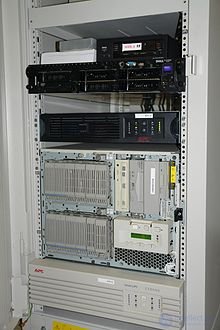
Промышленное решение: ИБП, вместе с защищаемым оборудованием, смонтирован в 19-дюймовую стойку
Стандартом IEC 62040-3 введена следующая классификация ИБП:
Пример обозначения типа ИБП: VFI SS 111
1-я группа символов — зависимость выходного сигнала ИБП от входного (сети).
2-я группа символов — форма выходного сигнала ИБП.
3-я группа символов — динамические характеристики ИБП. Обеспечение стабильности выходного напряжения ИБП при трёх типах переходных процессов (1 — класс 1, отлично; 2 — класс 2, хорошо; и т. д.):
|
|
В этом разделе не хватает ссылок на источники информации.
Информация должна быть проверяема, иначе она может быть поставлена под сомнение и удалена. |
14 февраля 2007 года на мировом рынке источников бесперебойного питания произошло важное событие: компания Schneider Electric завершила приобретение APC и объединение её с подразделением MGE (занимающимся трёхфазными ИБП большой мощности).
В конце июня 2007 однофазный бизнес (MGE OPS) концерн Schneider Electric продаёт компании Eaton Corporation (оборудование под маркой Powerware).
В 2010 году группой Legrand было принято решение и воплощено в жизнь приобретение концерна Inform Electronic. Теперь ИБП Inform, маркируются «by Legrand».
ИБП производства General Electric также известны по предыдущему производителю как Victron или IMV (Invertomatic Victron).
На 2013 год АРС by Schneider Electric является основным вендором и уже долгое время с явным отрывом сохраняет лидерство на рынке ИБП. [2]
Распределение продаж ИБП по производителям (2006 г., «IT Research»):
| Вендор | Млн долл. | % |
|---|---|---|
| APC | 233,7 | 54,6 % |
| Ippon | 42.0 | 7,3 % |
| Powercom | 24,1 | 3,9 % |
| GE | 22.3 | 4,5 % |
| GMUPS | 19.2 | 4,0 % |
| Eaton Powerware | 20.4 | 5,0 % |
| Emerson NP | 18,2 | 4,5 % |
| Powerman | 16.8 | 4,1 % |
| MGE UPS Systems | 12.2 | 3,01 % |
| GE Digital Energy | 9,1 | 2,2 % |
| Chloride | 6.7 | 1,66 % |
| INELT | 4,9 | 1,21 % |
| AEG Power Solutions | 3,7 | 0,91 % |
| NeuHaus | 3,7 | 0,90 % |
| Newave | 3.1 | 0.76% |
| Socomec Sicon UPS | 2.3 | 0.58% |
| Sven | 1.9 | 0.46% |
| Riello | 1.8 | 0.45% |
| Tripp lite | 0.5 | 0.13% |
| Lighthouse | 0.5 | 0.13% |
| Bluewalker | 0.2 | 0.04% |
| Inform Elektronik | 0.1 | 0.03% |
| Infosec | 0.04 | 0.01% |
| Total | 428.24 | 100.00% |
продолжение следует...
Часть 1 Uninterruptible Power Supply
можно ли ставить в ИБП батарею аккумулятор большей емкости?
У нас на работе энергетики из настольных ибпшников вытаскивают штатные аккумуляторы и цепляют к ним внешние на 55-65 ah. Нормально работают. Правда для сильно больших по емкости аккумуляторов желательно охлаждение делать в ИБП.
. ИБП зарядит любую батарею. разница только во времени зарядки. 190ач заряжает двое суток 500ватный бесперебойник. проверенно лично. зато на нем комп работает 8часов свободно ! греется только.
можно автомобильный на 70 поставить. У меня в параллели 2 штуки стоит, тв держит около 2х часов с роутером.
правда итал в нете что чрезе пару месяцев чтото выходит из строя в ИБП в таком режиме
Мой ИБП хранился в течении года. Не испортились ли батареи?
Так как батареи не использовались и не подзаряжались, их срок службы сократится.
В соответствии с характеристиками саморазряда свинцово-кислотных батарей, их обязательно следует заряжать каждые 6-10 месяцев в ходе
хранения. В противном случае, через 18-30
месяцев емкость будет необратимо уменьшаться. Для того чтобы продлить срок хранения батарей без зарядки, следует хранить их при температуре 10°C или ниже.
. Какой средний срок эксплуатации батарей ИБП?
Стандартный срок для батарей типа VRLA –
от трех до пяти лет. Однако, ожидаемый
срок эксплуатации может сильно меняться
в зависимости от условий окружающей
среды, количества циклов разряда и качества
обслуживания. Составьте календарь
обслуживания и контроля батарей для того,
чтобы вовремя определить момент, когда
потребуется замена. Обычный срок эксплуатации
батарей в ИБП Eaton с технологией ABM® на 50%
продолжительнее, в обычных моделях ИБП
Стандартный срок для батарей типа VRLA –
от трех до пяти лет. Однако, ожидаемый
срок эксплуатации может сильно меняться
в зависимости от условий окружающей
среды, количества циклов разряда и качества
обслуживания. Составьте календарь
обслуживания и контроля батарей для того,
чтобы вовремя определить момент, когда
потребуется замена. Обычный срок эксплуатации
батарей в ИБП Eaton с технологией ABM® на 50%
продолжительнее, в обычных моделях ИБП
Как я могу убедиться в том, что батареи ИБП находятся в хорошем состоянии
и обеспечат полноценное время поддержания питания нагрузки в случае отключения электроэнергии? Какие профилактические процедуры должны производиться и как часто?
Наиболее часто в ИБП используют
батареи типа VRLA (свинцово-кислотные с
регулирующими клапанами), также известные,
как герметичные или необслуживаемые.
Несмотря на то, что корпус таких батарей
герметичен, и вам не требуется проверять
уровень электролита, требуется уделять
им внимание для гарантии правильного
функционирования. Технология ABM от
Eaton продлевает срок службы батарей VRLA
с помощью применения интеллектуального
алгоритма заряда. Так же ABM обеспечивает
дополнительные возможности контроля
состояния батареи и предварительное
предупреждение о скором окончании срока
службы батареи
. Почему батареи выходят из строя?
Причин выхода из строя батарей очень много, ниже приведены наиболее частые причины:
высокая или неравномерная температура
неправильное напряжение заряда
некачественные внутренние соединения
между ячейками
потеря электролита вследствие высыхания или повреждения корпуса
недостатки обслуживания, старение
Comments
To leave a comment
Power supplies for electronic equipment
Terms: Power supplies for electronic equipment